
Economics_-_New_Ways_of_Thinking
.pdf
Do People Around the World Work the Same Number of Hours?
??????????????????
Workers in different countries don’t always work the
same number of hours a year. For example, the following table shows the average hours worked by a worker in three countries in 2003.
Country |
Hours worked |
Australia |
1,814 |
Japan |
1,801 |
United States |
1,792 |
In contrast, here are the average hours worked by a worker in three other countries.
Country |
Hours worked |
Sweden 1,564
France 1,453
Norway 1,337
It is also the case that the percentage of the workforce that works more than 40 hours a week varies from country to country. For example, in Japan, 75.9 percent of the workforce works more than 40 hours a week and in the United States it is 67.6 percent. In contrast, in France 21.4 percent of the workforce works more than 40 hours a week and in Norway it is 15.8 percent.
Do workers in some countries simply have a stronger preference for leisure (over work) than in other
countries? For example, do the French and the Norwegians place a higher value on leisure time than the Americans and the Japanese? It is possible, but it could also be something else. Taxes, for example, are higher in some countries than in other countries. The difference between “what one earns” and “what one gets to keep” (after taxes) is the money reward for working. We would expect where the money reward from working is lower, people would want to work less, and where the money reward from working is higher, people would want to work more.
If we look at total tax receipts as a percentage of income earned, we find that percentage to be lower in Australia, Japan, and the United States—all countries where workers work relatively more hours. For example, in Australia this percentage was recently 31.5 percent, in Japan it was 27.1 percent, and in the United States it was 29.6 percent.
In contrast, in Sweden, France, and Norway, total tax receipts as a percentage of income earned was much higher. It was 54.2 percent in Sweden, 45.3 percent in France, and 40.3 percent in Norway.
Another explanation of why people work more or fewer hours has to do with how well one can do if he or she does not work. In some countries, the social assistance given to the unemployed is higher than in other countries. All other things being equal, we would expect that “not working” causes fewer
This sign in Madrid, Spain, says the store will be closed until September.
What reasons might explain why workers would choose to take long vacations?
problems in a country that provides relatively greater social benefits.
Taxes and social spending may not explain all the difference between hours worked, however.
It is still possible that people in various countries are willing to make different trade-offs when it comes to labor and leisure. After all, some people, within a country, for whatever reason, seem to value leisure more than others. The same effect might occur, on average, between people in different countries.
Suppose that 60 percent of the difference between hours worked is explained
by taxes and social spending, and 40 percent is explained by different trade-offs people in different countries make. What might make one person value leisure more than another person?
34 Chapter 2 Economic Systems and the Global Economy
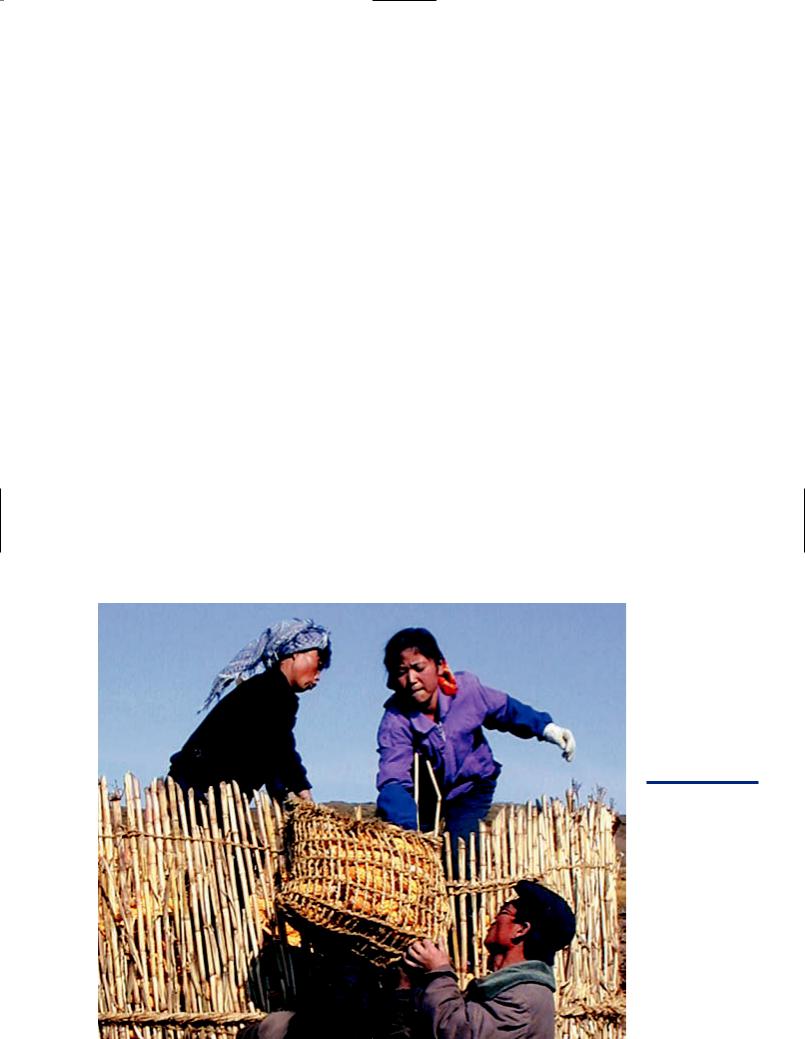
Government’s Role in the Economy
In a free enterprise economic system, government plays a small role in the economy. It does not make decisions on things like what goods and services will be produced or how they will be produced. Under socialism, government may make those decisions. For example, in the United States, the federal government doesn’t make decisions on how many pairs of shoes will be produced in the country, or how many cars, television sets, or computers. These decisions are made by individuals in private firms. In contrast, in North Korea today the government sets production levels for almost all products.
Economists tell a story about the days of the Soviet Union when the Soviet official who was in charge of deciding what goods got produced came to the United States. When he arrived in the United States, his U.S. hosts asked him if he would like to meet anyone in particular. He told his hosts he wanted to meet his counterpart in the United States—the person who decided what goods would be produced. His hosts told him no such person existed in the United States. The Soviet official was shocked and couldn’t understand how things got done in the United States if no one was issuing economic orders.
Economic Plans
Under socialism, government decision makers may write an economic plan, a plan that specifies the direction economic activities are to take. For example, a plan may state that over the next five years, the nation’s economy will produce more manufactured goods (such as cars and trucks) and fewer agricultural goods (such as wheat and corn). A free enterprise economic system would have no such plan.
Income Distribution
Income distribution refers to how all the income earned in a country is divided among different groups of income earners. For example, the top 10 percent of income earners may earn 20 percent of the total income of the country, whereas the bottom 10 percent of income earners may earn 4 percent of the total income of the country. In a free enterprise economic system less attention is paid to the income distribution than in a socialist economic system. Government decision makers under socialism are more likely to use government’s powers to redistribute income, usually directing it away from society’s high earners.
economic plan
A government program specifying economic activities, such as what goods are to be produced and what prices will be charged.
income distribution
The way all the income earned in a country is divided among different groups of income earners.
These North Korean workers are storing maize on a cooperative farm.
Who do you think determines the production levels that these workers are expected to achieve?
35

Controlling Prices
In a free enterprise economic system, prices are allowed to fluctuate—that is, to go up and down. Government does not attempt to control prices. In a socialist economic system, government decision makers do control prices, although not all socialist systems control prices to the same extent. For example, government decision makers may say that no one can buy or sell bread for more than $1.50 a loaf. Or they may say wage rates for unskilled labor are too low at $4 an hour and order that no one be allowed to “buy” or “sell” unskilled labor for less than $6 an hour.
Private Property
Under free enterprise, private property is sacred. The proponents of free enterprise believe that if you own something yourself— if, say, your house is your private property— you are more likely to take care of it than if it were owned communally by you and others or owned by the government.
These quality-control inspectors work at a Toyota plant in the United States. What are the advantages and disadvantages of such factories being owned by individuals or companies, as opposed to being owned by a government?
The proponents also believe that having private property encourages individuals to use their resources in a way that benefits others. For example, suppose Johnson owns a factory that is her private property. If Johnson wants to maximize her income, she will have to use her factory to produce goods that people are willing and able to buy. If she did otherwise and produced something that people were unwilling and unable to buy, she would not benefit the people nor earn an income.
The socialist view of things is different. Socialists believe that those who own property will end up having more political power than those who do not own it. Furthermore, they will use their greater political power to their advantage and to the disadvantage of others. According to socialists, it would be better for government to own most of the nonlabor property in the economy (such things as factories, raw materials, and machinery). Government would be more likely than private individuals to make sure this property was used to benefit the many instead of the few.
Mixed Economies
You might be wondering whether we can easily place each country’s economy in either the free enterprise or socialism camp. The answer is no. In reality, a country’s economic system may contain some ingredients of free enterprise and some ingredients of socialism too. For example, the United States is considered to have a free enterprise economic system. After all, most of the resources are owned by private individuals, and no overall economic plans determine the use of those resources. However, the U.S. government plays a larger role in the economy than it would play in a pure free enterprise system, and some prices are controlled. Thus, while the United States is considered a free enterprise nation, it has a few features of socialism.
A similar point can be made for other nations. For example, China is considered to be a communist country. However, since 1978, China has experimented with numerous market, or free enterprise, practices; so
36 Chapter 2 Economic Systems and the Global Economy
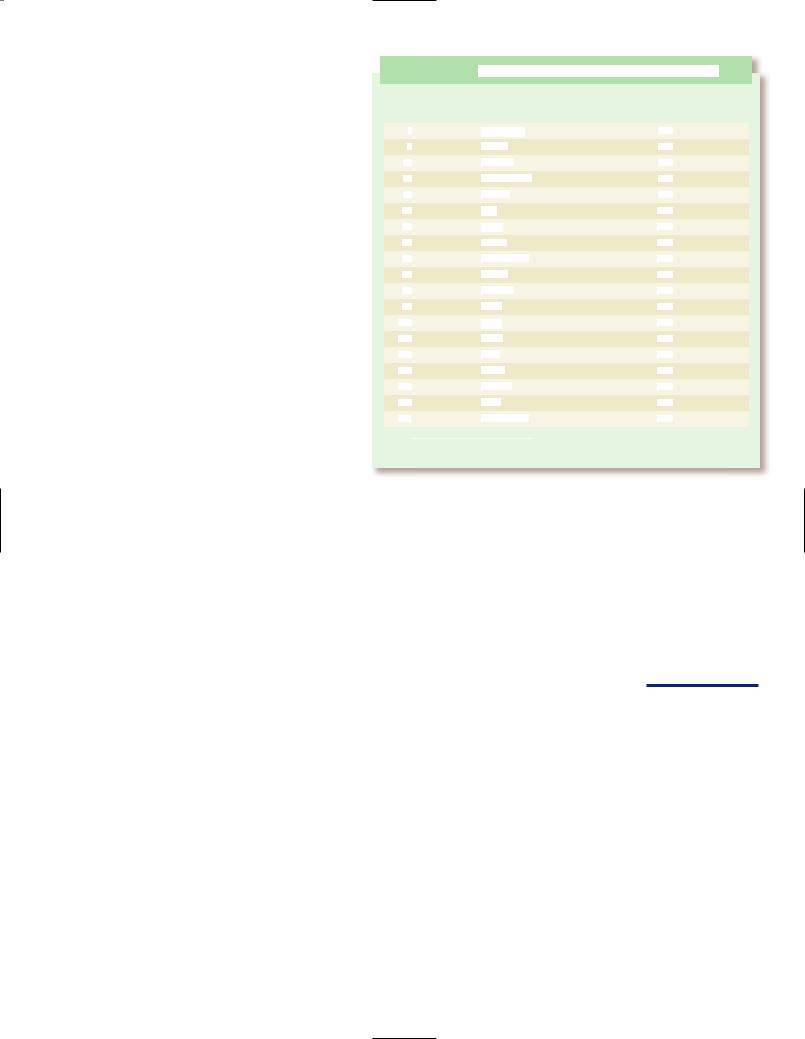
to say that China is 100 percent socialist would be incorrect.
Economies with features of both free enterprise and socialism are called mixed economies. If we were to adopt this terminology, we would have to say that both the U.S. and Chinese economies are mixed economies. However, to call them both mixed economies could be misleading. It makes them sound alike (even identical) when they are not. The United States has much more free enterprise than China, and China has much more socialism than the United States; the economies of these two nations are different. It is clearer to refer to the United States as a free enterprise nation and to China as principally a socialist nation, while noting some socialist practices occur in the United States and some free enterprise practices take place in China.
Each year the Wall Street Journal and the Heritage Foundation rank countries according to how much economic freedom and free enterprise exist in the country. In 2005, they scored 155 countries on a scale of 1 to 5. The closer a country’s index of economic freedom number is to 1, the more economic freedom and free enterprise in the country; the closer a country’s index of economic freedom number is to 5, the less economic freedom in the country.
Keep in mind that different organizations can sometimes rank countries differently as to how much economic freedom exists in the country. We show the rankings and index numbers for selective countries in Exhibit 2-1. (Hong Kong had the most economic freedom and North Korea the least.)
Economic Systems: Past,
Present, and Future
Before economies were free enterprise or socialist, many were traditional economies. A traditional economy is an economic system in which the answers to the three economic questions are based on customs, skills, and cultural beliefs.
In a traditional economy, these customs, skills, and beliefs are passed on from one generation to the next. An example of a tra-
|
E X H I B I T 2-1 |
|
|
|
|
|
|
|
|
|
|
|
|
|
|
|
|
|
|
|
|
|
|
|
|
|
|
|
|
|
|
|
|
|
|
||||||
Index of Economic Freedom Scores |
|||||||||||||||||||||||||||||||||||||||||
|
|
|
|
|
|
|
|
|
|
|
|
|
|
|
|
|
|
|
|
|
|
|
|
|
|
|
|
|
|
|
|
|
|
|
|
|
|
|
|
|
|
|
|
|
|
|
|
|
|
|
|
|
|
|
|
|
|
|
|
|
|
|
|
|
|
|
|
|
|
|
|
|
|
|
|
|
|
|
|
|
|
|
|
|
Rank |
|
|
Country |
Index of Economic Freedom Score |
||||||||||||||||||||||||||||||||||||
|
|
|
|
|
|
|
|
|
|
|
|
|
|
|
|
|
|
|
|
|
|
|
|
|
|
|
|
|
|
|
|
|
|
|
|
|
|
|
|
|
|
|
|
|
|
|
|
|
|
|
|
|
|
|
|
|
|
|
|
|
|
|
|
|
|
|
|
|
|
|
|
|
|
|
|
|
|
|
|
|
|
|
|
|
|
|
|
1 |
|
|
Hong Kong |
|
|
|
1.35 |
|
|
||||||||||||||||||||||||||||
|
|
|
|
|
|
|
|
|
|
|
|
|
|
|
|
|
|
|
|
|
|
|
|
|
|
|
|
|
|
|
|
|
|
|
|
|
|
|
|
||
|
|
|
|
|
|
|
|
Ireland |
|
|
|
|
|
|
|||||||||||||||||||||||||||
|
|
|
|
5 |
|
|
1.70 |
|
|
||||||||||||||||||||||||||||||||
|
|
|
|
|
|
|
|
|
|
|
|
|
|
|
|
|
|
|
|
|
|
|
|
|
|
|
|
|
|
|
|
|
|
|
|
||||||
|
|
|
|
|
|
|
|
|
Australia |
|
|
|
|
|
|
||||||||||||||||||||||||||
|
|
|
10 |
|
|
1.79 |
|
|
|||||||||||||||||||||||||||||||||
|
|
|
|
|
|
|
|
|
|
|
|
|
|
|
|
|
|
|
|
|
|
|
|
|
|
|
|
|
|
|
|
|
|
|
|
||||||
|
|
|
|
|
|
|
|
United States |
|
|
|
|
|
|
|||||||||||||||||||||||||||
12 |
|
|
1.85 |
|
|||||||||||||||||||||||||||||||||||||
|
|
|
|
|
|
|
|
|
|
|
|
|
|
|
|
|
|
|
|
|
|
|
|
|
|
|
|
|
|
|
|
|
|
|
|||||||
|
|
|
|
|
|
|
|
Canada |
|
|
|
|
|
|
|||||||||||||||||||||||||||
16 |
|
|
1.91 |
|
|||||||||||||||||||||||||||||||||||||
|
|
|
|
|
|
|
|
|
|
|
|
|
|
|
|
|
|
|
|
|
|
|
|
|
|
|
|
|
|
|
|
|
|||||||||
|
|
|
|
|
|
|
|
Italy |
|
|
|
|
|
|
|||||||||||||||||||||||||||
|
|
|
26 |
|
|
2.28 |
|
|
|||||||||||||||||||||||||||||||||
|
|
|
|
|
|
|
|
|
|
|
|
|
|
|
|
|
|
|
|
|
|
|
|
|
|
|
|
|
|
|
|||||||||||
|
|
39 |
|
|
|
|
Japan |
|
2.46 |
|
|
||||||||||||||||||||||||||||||
|
|
|
|
|
|
|
|
|
|
|
|
|
|
|
|
|
|
|
|
|
|
|
|
|
|
|
|
|
|
|
|
|
|||||||||
|
|
44 |
|
|
|
|
|
|
France |
|
2.63 |
|
|
||||||||||||||||||||||||||||
|
|
|
|
|
|
|
|
|
|
|
|
|
|
|
|
|
|
|
|
|
|
|
|
|
|
|
|
||||||||||||||
|
|
|
|
|
|
|
|
|
South Korea |
|
|
|
|
|
|
||||||||||||||||||||||||||
|
|
45 |
|
|
2.64 |
|
|
||||||||||||||||||||||||||||||||||
|
|
|
|
|
|
|
|
|
|
|
|
|
|
|
|
|
|
|
|
|
|
|
|
|
|
|
|
||||||||||||||
|
|
63 |
|
|
|
|
|
|
Mexico |
|
2.89 |
|
|
||||||||||||||||||||||||||||
|
|
|
|
|
|
|
|
|
|
|
|
|
|
|
|
|
|
|
|
|
|
|
|||||||||||||||||||
|
|
|
|
|
|
|
|
|
Thailand |
|
|
|
|
|
|
||||||||||||||||||||||||||
|
|
71 |
|
|
2.98 |
|
|
||||||||||||||||||||||||||||||||||
|
|
|
|
|
|
|
|
|
|
|
|
|
|
|
|
|
|
|
|
|
|
||||||||||||||||||||
|
|
|
|
|
|
|
Brazil |
|
|
|
|
|
|||||||||||||||||||||||||||||
|
|
|
|
90 |
|
|
3.25 |
|
|
||||||||||||||||||||||||||||||||
|
|
|
|
|
|
|
|
|
|
|
|
|
|
|
|
|
|
|
|
|
|
|
|
||||||||||||||||||
|
103 |
|
|
|
|
|
|
|
|
Egypt |
|
3.38 |
|
|
|||||||||||||||||||||||||||
|
|
|
|
|
|
|
|
|
|
|
|
|
|
|
|
|
|
|
|
|
|||||||||||||||||||||
|
|
|
|
|
|
|
|
China |
|
|
|
|
|
||||||||||||||||||||||||||||
112 |
|
|
3.46 |
|
|||||||||||||||||||||||||||||||||||||
|
|
|
|
|
|
|
|
|
|
|
|
|
|
|
|
|
|
|
|
||||||||||||||||||||||
|
|
|
|
|
|
|
|
India |
|
|
|
|
|
||||||||||||||||||||||||||||
|
|
118 |
|
|
3.53 |
|
|
||||||||||||||||||||||||||||||||||
|
|
|
|
|
|
|
|
|
|
|
|
|
|
|
|
|
|
|
|||||||||||||||||||||||
|
124 |
|
|
|
Russia |
|
3.56 |
|
|
||||||||||||||||||||||||||||||||
|
|
|
|
|
|
|
|
|
|
|
|
|
|
|
|
|
|||||||||||||||||||||||||
|
137 |
|
|
|
Vietnam |
|
3.83 |
|
|
||||||||||||||||||||||||||||||||
|
|
|
|
|
|
|
|
|
|
|
|
|
|
|
|
||||||||||||||||||||||||||
|
|
|
|
|
|
|
|
|
|
|
Cuba |
|
|
|
|
|
|||||||||||||||||||||||||
149 |
|
|
4.29 |
|
|||||||||||||||||||||||||||||||||||||
|
|
|
|
|
|
|
|
|
|
|
|
||||||||||||||||||||||||||||||
|
|
|
|
|
|
|
|
|
North Korea |
|
|
|
|
||||||||||||||||||||||||||||
|
155 |
|
|
5.00 |
|
|
|||||||||||||||||||||||||||||||||||
Source: 2005 Index of Economic Freedom, a joint publication of the Wall Street Journal and
Heritage Foundation.
ditional economy is the old feudal system in Western Europe. Under the feudal system, all land was owned by a king. The king granted land to nobles, who in turn granted small plots of land to peasants to farm. The peasants kept part of what they produced; the remainder went to the nobles and, ultimately, to the king.
Few traditional economies exist today. Most economies today are mixed economies. Of course, the “mixture” of free enterprise and socialism often differs between nations’ economies.
What does the future hold? Will most economies of the future be mixed economies (as they are today)? More importantly, will the mix between free enterprise and socialism in the future be the same as the mix that exists today? For instance, if we considered a representative mixed economy today, and noted that it is 65 percent free enterprise and 35 percent socialist, will this same 65/35 mix hold for the representative economy in 2015, or 2025? This question concerns much of what we will be discussing in the next section, when we talk about globalization.
Countries were scored according to economic freedom on a scale of 1.00 to 5.00. The lower the score, the more economic freedom in the country; the higher the score, the less economic freedom.
mixed economy
An economy that is neither purely capitalist nor purely socialist; an economy that has some elements of both capitalism and socialism. Most countries in the world have mixed economies.
traditional economy
An economic system in which the answers to the three economic questions are based on customs, traditions, and cultural beliefs.
Section 1 Economic Systems |
37 |
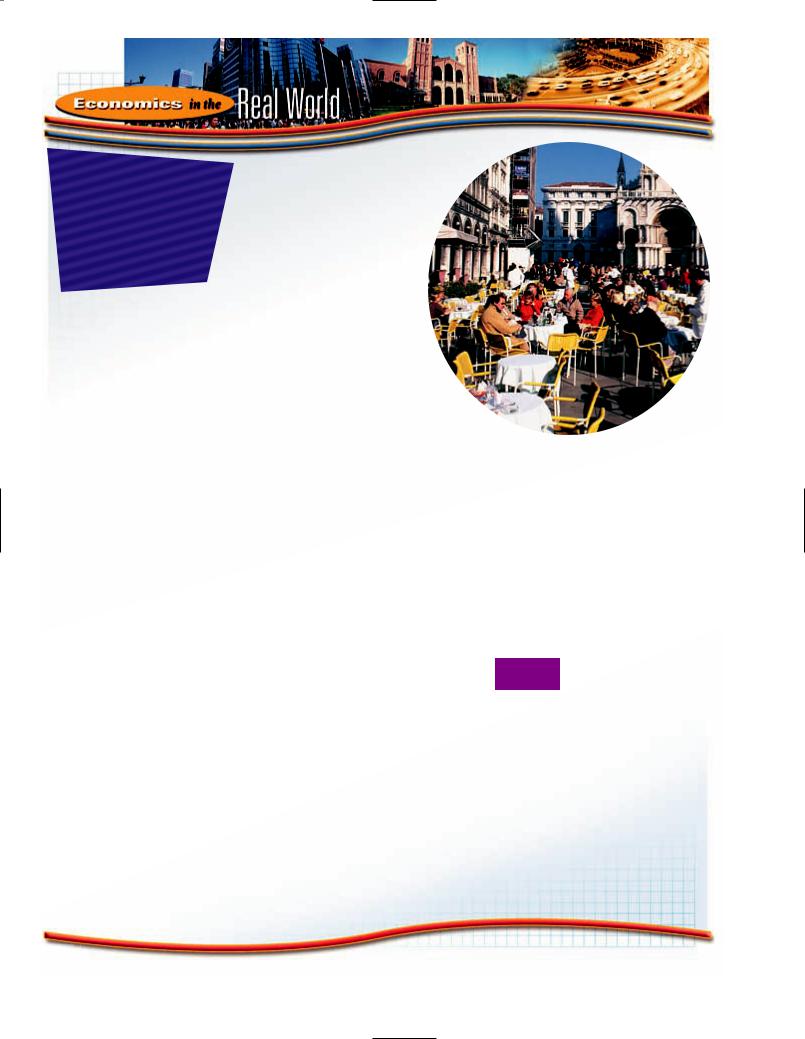
What ?
Should
I Tip?
IIn the United States, tipping in restaurants amounts to $16 bil-
lion a year. Even though tipping in the United States is common today, 24 percent of the individuals in one study said that they thought tipping was unfair to customers. In the past, some states prohibited tipping. For example, in the early 1900s, Arkansas, Mississippi, Iowa, South Carolina, Tennessee, and Washington passed laws to prohibit tipping.
What about the rest of the world? Do people around the world have the same tipping practices as Americans do? Some do, but certainly not all. For example, it is increasingly more customary in European restaurants to have an automatic service charge added to a restaurant bill than to tip the server. Little tipping of any sort goes on in Argentina and Vietnam. Much less tipping occurs (fewer service providers expect tips) in Australia, New Zealand, and Italy than in the United States, and more tipping goes on in Mexico and Egypt than in the United States.
In several studies, researchers looked at the number of different service providers (out of a total of 33) for which tipping is customary
in a given country. The more service providers it was cus tomary to tip in a country, the higher the country’s “prevalence of tipping.”
For example, if it was customary to tip 31 different service providers in country A but only 15 in country B, then country A would have a higher prevalence of tipping than country B.
The conclusion of these studies is that countries success and materialism
highly valued had a higher prevalence to tip than countries where caring and personal relationships were highly valued. Also, the prevalence of tipping increased as the national need for achievement and recognition rose. In one study, tipping was more prevalent in countries with lower taxes than in countries with higher taxes.
If it becomes increasingly relevant to speak of a world economy instead of hundreds of national economies, will tipping practices around the world become more the same? If they do become more similar from country to country, will countries gravitate toward more or less tipping?
We do not know the answer to this question, so you might then wonder: Why ask? First, it gets us to thinking about what changes we are likely to see in our everyday lives as globalization continues. Second, it causes us to wonder whether those
changes will affect economic issues only (we can buy more clothes from China), or spread into the social and cultural parts of life too. And third, asking such questions helps us see which practices are deeply embedded in the character of a people (and therefore unlikely to change) and which ones are superficial (and therefore more likely to change).
1. Compare two tipping practices. In the
first, a customer at a restaurant decides whether to tip a server. In the second, a 15 percent service charge is added to the restaurant bill. Which practice, if either, is more likely to guarantee good service and why?
2. Do you think that a society’s general tipping practices might reflect the values of that society? If so, give an example.
38 Chapter 2 Economic Systems and the Global Economy
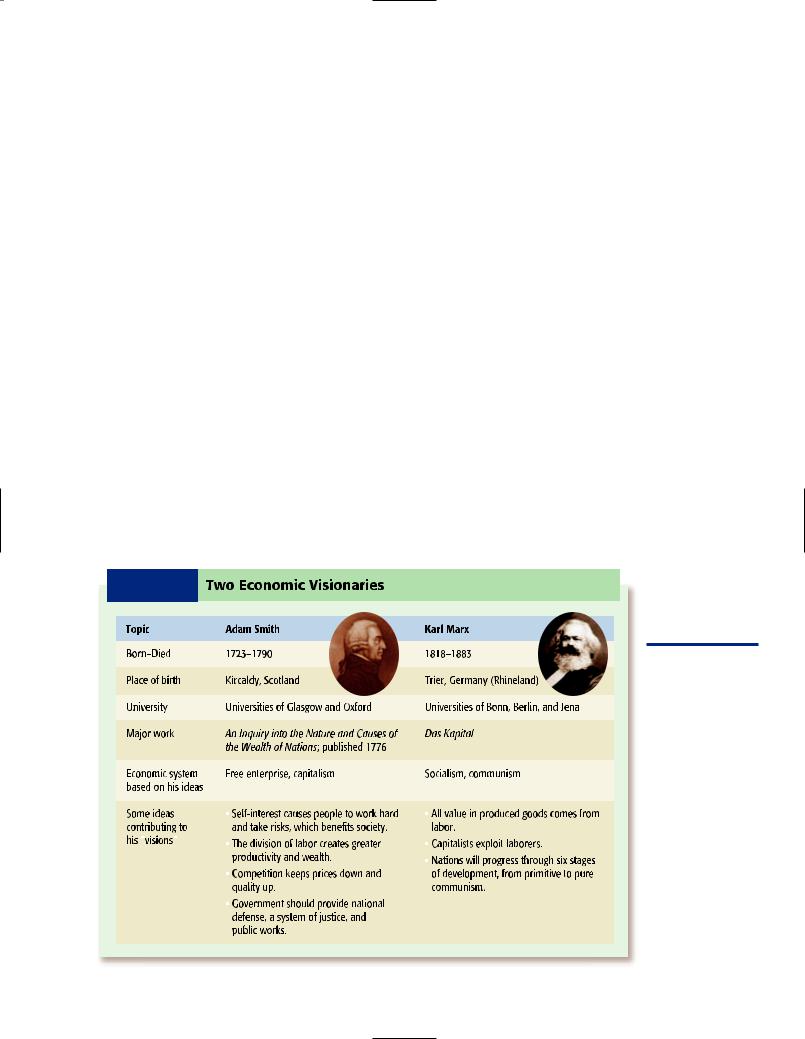
The Visions Behind Free
Enterprise and Socialism
Both free enterprise and socialism are the products of certain visions—ways of looking at, understanding, and explaining the world. Adam Smith, the eighteenth century economist, is a major thinker whose ideas are fundamental to free enterprise. For Smith, free enterprise is not only the economic system that produces the most economic wealth (the most goods and services), but it is the most ethical of the economic systems too.
In contrast, the ideas of Karl Marx, a nineteenth century economist, are at the heart of socialism (and communism). It was Marx who pointed out what he believed were many of the failures and injustices of free enterprise. In his major work, Das Kapital, he presents his vision for an alternative system.
How important are the ideas of these two men? As one example, in late 1999, Life magazine created a list of the 100 most important people of the second millennium (1000–1999). Both Smith and Marx were on the list. (See Exhibit 2-2 for more information about both Smith and Marx.)
To get a sense of how their visions differed, and therefore how the two major economic systems differ, let’s take a closer look at one major idea from both Smith and Marx. For Smith, it is the idea that selfinterest can lead to good things not only for the individual, but for others too.
Self-Interest
Smith said that from the minute we enter this world until the day we go to our graves, we feel a desire to make ourselves better off. Smith felt that self-interest is a major part of who we are. He believed that our self-interest prompts us to work hard, take risks, and in the end benefit others through our activities.
How can we benefit others through our self-interest? After all, doesn’t a person’s selfinterest pit that person against the best interests of others? Smith believed that if people wanted to serve their own self-interest, they had to serve others first. In a passage from his major work, The Wealth of Nations, Smith says:
It is not from the benevolence of the butcher, the brewer, or the baker, that we expect our dinner, but from their regard
vision
A sense of how the world works.
E X H I B I T 2-2 Two Economic Visionaries
Topic |
Adam Smith |
Karl Marx |
Born Died |
1723 |
1790 |
1818 |
1883 |
Place of birth
University
Major work
Economic system based on his ideas
Some ideas contributing to his  visions
visions
Kircaldy, Scotland
Universities of Glasgow and Oxford
An Inquiry into the Nature and Causes of the Wealth of Nations; published 1776
Free enterprise, capitalism
 Self-interest causes people to work hard and take risks, which benefits society.
Self-interest causes people to work hard and take risks, which benefits society.
 The division of labor creates greater productivity and wealth.
The division of labor creates greater productivity and wealth.
 Competition keeps prices down and quality up.
Competition keeps prices down and quality up.
 Government should provide national defense, a system of justice, and public works.
Government should provide national defense, a system of justice, and public works.
Trier, Germany (Rhineland)
Universities of Bonn, Berlin, and Jena
Das Kapital
Socialism, communism
 All value in produced goods comes from labor.
All value in produced goods comes from labor.
 Capitalists exploit laborers.
Capitalists exploit laborers.
 Nations will progress through six stages of development, from primitive to pure communism.
Nations will progress through six stages of development, from primitive to pure communism.
The ideas of Adam Smith and Karl Marx have changed the world.
Section 1 Economic Systems |
39 |

labor theory of value
The belief that all value in produced goods is derived from labor.
surplus value
The difference between the total value of production and the subsistence wages paid to workers.
to their own interest. We address ourselves, not to their humanity but to their self-love, and never talk to them of our own necessities but of their advantages.
In other words, the butcher, brewer, and baker do not give us our dinner because they love us or because they want to assist us. They give us our dinner because they cannot get what they want from us until they first give us what we want. According to Smith, we are led by an “invisible hand” to do good for others. In probably the most famous passage in The Wealth of Nations, he says:
Every individual . . . neither intends to promote the public interest, nor knows how much he is promoting it . . . he intends only his own gain, and he is in this, as in many other cases, led by an invisible hand to promote an end which was no part of his intention.
Labor Theory of Value
Karl Marx saw things very differently. He didn’t see self-interest as leading to good things; instead, he saw it as hurting others. Marx believed that capitalists, in pursuing
Marx argued in his labor theory of value that all value in produced goods comes from labor. The value of any item, he said, is determined by the necessary labor time needed to produce that item. For example, if it takes 5 hours of labor time to produce a chair and 10 hours to produce a table, then the table is twice as valuable as the chair.
Marx believed that the owners of factories and businesses exploited the workers by paying them far less than they were worth. For example, suppose a worker produced $100 a day worth of value for the factory owner but was only paid $20. The difference between the total value of production ($100) and the wages paid to the worker ($20) is what Marx called surplus value ($80). According to Marx this surplus should go to the worker, but instead is stolen by the capitalist for himself.
Ideas That Changed the World
The ideas of both Smith and Marx have been with us for many years. Smith’s ideas compose much of the foundation upon which free enterprise rests, while Marx’s ideas provide much of the foundation for socialism Their ideas have changed the
Defining Terms
1.Define:
a.economic system
b.free enterprise
c.socialism
d.traditional economy
e.economic plan
f.surplus value
Reviewing Facts and
Concepts
2.What are the three economic questions every society must answer?
3.What is the difference between free enterprise (or capitalism) and
socialism as each relates to private property?
4.Are all mixed economies the same? Explain your answer.
5.What is Smith’s position on self-interest?
6.Explain Marx’s labor theory of value.
Critical Thinking
7.Why do you think that most economies are mixed economies instead of purely capitalist or purely socialist economies?
Applying Economic
Concepts
8.Choose a current economic issue or policy measure and then contrast the way a proponent of capitalism would discuss it versus how a proponent of socialism would discuss it.
40 Chapter 2 Economic Systems and the Global Economy

Globalization
Focus Questions
What is globalization?
What are the causes of globalization?
What evidence indicates that globalization is taking place?
What are the benefits of globalization?
What are the costs of globalization?
Is the trend toward globalization likely to continue?
Key Terms
globalization offshoring
What Is Globalization?
From the 1950s through the 1980s, it was common to hear people talk about a capitalist or free enterprise country, and about a socialist or communist country. It was as if each country in the world was definitely one or the other. It was also the case that for the most part these countries only associated (politically and economically) with their “own kind.”
Things have changed. Few countries can be easily labeled “capitalist” or “socialist,” and countries that never communicated have become major trading partners. Why? Well, according to many thinkers, it’s because of globalization.
So what is this thing called globalization? Many economists define it as a process by which individuals and businesses in any part of the world are much more affected by events elsewhere in the world than they used to be. Globalization can also be defined as the growing integration of the national economies of the world. Some believe that this integration may eventually lead to the
existence of a single worldwide economy. Let’s take a closer look at some of the key features of globalization.
A Smaller World
The first definition of globalization emphasizes that economic agents (individuals, businesses, governments) in any given part of the world are affected by events elsewhere in the world. In other words, living in the United States, you are not only affected by what happens in the United States, but what happens in Brazil, Russia, and China.
 In 2005, the Chinese government was taking much of the money it earned in trade with the United States and buying bonds issued by the U.S. government. As a result of Chinese purchases of U.S. bonds, interest rates in the United States ended up being lower than they would have been. Are you affected by interest rates? Sure you are whenever you buy a car, a house, or anything else you take out a loan to purchase.
In 2005, the Chinese government was taking much of the money it earned in trade with the United States and buying bonds issued by the U.S. government. As a result of Chinese purchases of U.S. bonds, interest rates in the United States ended up being lower than they would have been. Are you affected by interest rates? Sure you are whenever you buy a car, a house, or anything else you take out a loan to purchase.
globalization
A phenomenon by which economic agents in any given part of the world are affected by events elsewhere in the world; the growing integration of the national economies of the world to the degree that we may be witnessing the emergence and operation of a single worldwide economy.
Section 2 Globalization |
41 |
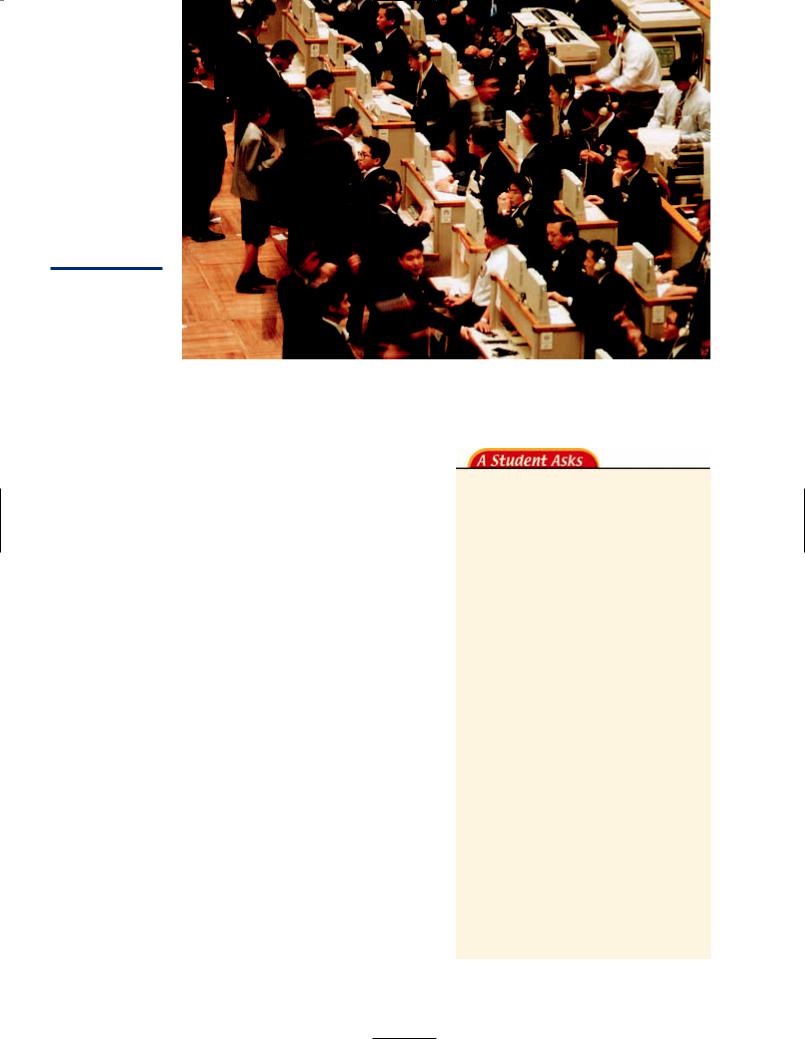
These financial workers are making and recording trades at the Tokyo Stock Exchange. Do you expect more or fewer Americans to buy and sell shares traded on this exchange in the years to come? Explain.
Can you see how, in a sense, globalization makes the world smaller? China hasn’t moved physically; it isn’t any closer to the United States (in terms of distance) than it was 100 years ago. Still, what happens in China today, because of globalization, has the same effect on you as what might happen 10 or 100 miles away from you. For all practical purposes, we live in a “smaller world” today than people did 100 years ago.
A Free Enterprise World
Globalization is closely aligned with a movement toward more free enterprise, freer markets, more freedom of movement for people and goods. Thomas Friedman, author of several books on globalization, states that “globalization means the spread of free-market capitalism in the world.” There is no doubt that many countries are moving toward greater free enterprise practices.
What does this trend mean for our study of economic systems? Speaking of various economic systems made sense when national economies were the most important economies. With globalization, however, the world is moving from hundreds of national economies toward one large world economy. In a world of one, it does not make sense to speak of different economic systems. It makes sense to speak of “the” economic system for that one world economy. And, the
economic system that best describes what is happening in the world economy is free enterprise or capitalism.
QUESTION: What specifically is the difference between a national economy and a global economy?
ANSWER: Think of an invisible string as connecting you and everyone you have an economic relationship with. If you buy something from someone, a string connects the two of you; if you work for someone, a string connects you. Now, perhaps the best way to think of a national economy is to think of strings only linking those people who reside in the same country. In a world or global economy, however, strings link individuals with people in their own country and in other countries too. In other words, their economic relationships extend beyond the nation’s borders. In the past, a few strings extended outside of country borders, but only a few, and for a long time the strings only went to certain countries. With globalization, more and more strings, a seemingly unlimited number of strings, are being connected across borders. And, these strings are being connected between people in more and more countries.
42 Chapter 2 Economic Systems and the Global Economy
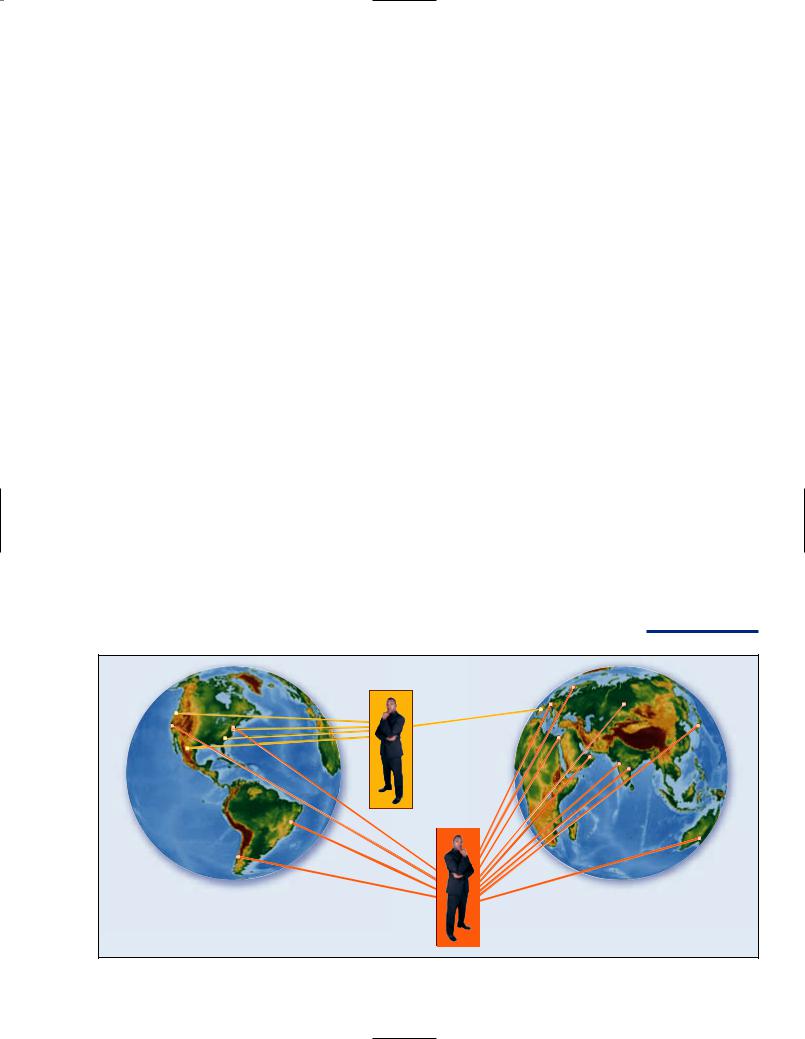
Movement Toward
Globalization
How did we come to live in a global economy? Did someone push a button years ago and start the process of globalization? No, things don’t happen that way.
Early History
Globalization did not just occur on the world stage two decades ago. The world has gone through different globalization periods. For example, during the period from the mid-1800s to the late 1920s, globalization was occurring. Some people today refer to it as the First Era of globalization. In some ways, that world was a freer world when it came to the movement of people than the world today, as evidenced by the fact that many people moved from country to country without a passport, which was not required.
This early era of globalization was largely ended by the two world wars (World War I and World War II) and the Great Depression. Even though both the Great Depression and both world wars were over by 1945, globalization did not start anew. The Cold War essentially divided the world into different camps (free vs. unfree, capitalist vs. communist), which led to relatively high political and economic barriers. The visible symbol of these barriers—the Berlin Wall—separated not only East from West Germany but one
group of countries living under one political and economic system from another group of countries living under a different political and economic system.
Recent Causes
Several factors have led to the more recent period of globalization. Let’s look at a few of the most frequently mentioned factors.
The End of the Cold War The Cold War intensified after World War II and, most agree, ended with the visible fall of the Berlin Wall in 1989. This event occurred while the Soviet empire was beginning to crumble and many of the communist East European countries were breaking away from Soviet control.
As some explain it, the end of the Cold War resulted in turning two different worlds (the capitalist and communist worlds) into one world. It resulted in a thawing of not only political but economic relations between former enemies.
Why was this important economically? People are reluctant to trade with their enemies, but once that person or country is no longer your enemy, the barriers begin to fade away. The Cold War acted as a political barrier between certain groups of countries. Once it ended, one giant barrier standing in the way of trade was no longer there.
In the past we traded exclusively with certain people, in certain countries. Today, with the movement toward globalization and worldwide free enterprise, we are more closely connected through trade with people all across the globe.
In the past |
Today |
Section 2 Globalization |
43 |
